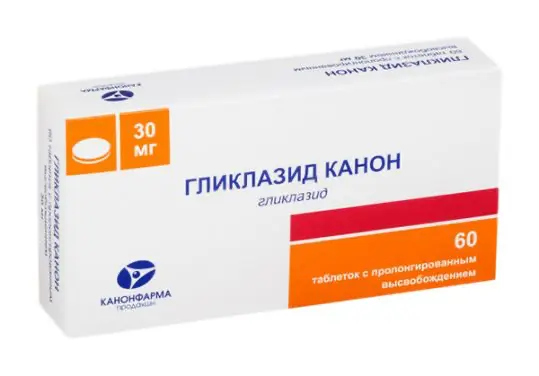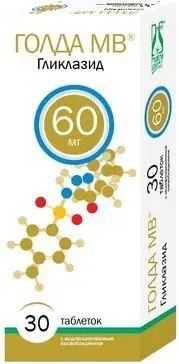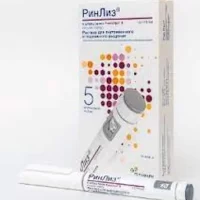Description
Gliclazide Kanon Pharmacodynamics
Gliclazide is a sulfonylurea derivative, hypoglycemic drug for oral administration, which differs from similar drugs by the presence of N-containing heterocyclic ring with endocyclic bond.
Gliclazide reduces blood glucose concentration by stimulating insulin secretion by beta cells of Langerhans islets. The increase in post-irradial insulin and C-peptide concentration persists after 2 years of therapy. In addition to its effect on carbohydrate metabolism, gliclazide has hemovascular effects.
Effect on insulin secretion
In type 2 diabetes, gliclazide restores the early peak of insulin secretion in response to glucose intake and enhances the second phase of insulin secretion. A significant increase in insulin secretion is observed in response to stimulation caused by food intake or glucose administration.
Hemovascular effects
Gliclazid decreases the risk of small vessel thrombosis by acting on the mechanisms which may contribute to the development of complications in diabetes: partial inhibition of platelet aggregation and adhesion and reduction of platelet-activating factors (beta-thromboglobulin, thromboxane B2), restoration of fibrinolytic activity of vascular endothelium and increase of tissue plasminogen activator activity. Intensive glycemic control based on the use of gliclazide with prolonged release (target glycosylated hemoglobin (HbAlc) < 6.5%) significantly reduces the risk of micro- and macrovascular complications of type 2 diabetes compared with standard glycemic control (ADVANCE study).
Indications
Diabetes mellitus type 2 with insufficient effectiveness of diet therapy, physical activity and body weight reduction.
Prevention of diabetes complications: reduction of risk of microvascular (nephropathy, retinopathy) and macrovascular complications (myocardial infarction, stroke) in patients with type 2 diabetes by intensive glycemic control.
Contraindications
– Hypersensitivity to gliclazide or any of the excipients of the drug, other sulfonylurea derivatives, sulfonamides;
– diabetes mellitus type 1;
– diabetic ketoacidosis, diabetic precoma, diabetic coma;
– Severe renal or hepatic insufficiency;
– taking miconazole;
– Pregnancy and breast feeding period;
– under 18 years of age.
It is not recommended to use the drug simultaneously in combination with phenylbutazone or dibazole.
Caution:
Elderly age, irregular and/or unbalanced diet, severe cardiovascular diseases (including coronary heart disease, atherosclerosis), hypothyroidism, adrenal or pituitary insufficiency, hypopituitarism, renal and/or liver failure, long-term therapy with glucocorticosteroids (GCS), alcoholism, glucose-6-phosphate dehydrogenase deficiency.
Pregnancy and lactation:
There is no experience with the use of gliclazide during pregnancy.
Data on the use of other sulfonylurea derivatives during pregnancy are limited.
Teratogenic effects of gliclazide have not been identified in studies on laboratory animals.
Oral hypoglycemic drugs are not used during pregnancy.
The drug of choice for the therapy of diabetes mellitus in pregnant women is insulin. It is recommended to replace gliclazide administration with insulin therapy, both if pregnancy is planned, and if pregnancy occurs against the background of taking the drug.
Breastfeeding period
Taking into account the lack of data on the intake of gliclazide in breast milk and the risk of neonatal hypoglycemia, breastfeeding is contraindicated during therapy with the drug.
Dosage and administration
- The drug is intended for adults only.
- The recommended dose of the drug should be taken orally, 1 time per day, preferably during breakfast.
- The daily dose is 30-120 mg (1-4 tablets) at 1 sitting. It is recommended to swallow the tablet whole, without chewing and crushing.
- If you miss one or more doses of the drug, you should not take a higher dose at the next appointment, the missed dose should be taken the next day. As with other hypoglycemic drugs, the drug dose in each case should be adjusted individually, depending on the blood glucose concentration and glycosylated hemoglobin (HbAlc).
Initial dose - Recommended initial dose in adults who have not been treated earlier (including elderly people aged ≥65 years) – 30 mg/day (1 tablet), then the dose is adjusted individually to achieve the desired result.
When replacing Gliclazide Canon with another hypoglycemic agent, no transition time is required. - You should first stop taking this drug and only then take Gliclazide Canon.
- Dosage adjustment
Increase the dose no earlier than 1 month of therapy with the drug in the previously prescribed dose. Dose should be adjusted according to the blood glucose concentration after the start of treatment. Each subsequent dose change can be undertaken after at least a two-week period. - Maintenance Therapy
The maintenance daily dose is 30 to 90 to 120 mg (1 to 3 to 4 tablets) and should not exceed 120 mg. Gliclazide Canon may be used in combination with biguanidines, alpha-glucosidase inhibitors, or insulin. - Elderly patients
The recommended doses of the drug in elderly patients are identical to those in adults under 65 years of age. - Renal failure
Recommended drug doses in mild to moderate renal insufficiency are identical with those in patients with normal renal function. Close medical monitoring of patients is recommended. - Patients at risk of hypoglycemia
In patients belonging to risk group of hypoglycemia development (insufficient or unbalanced nutrition; severe or poorly compensated endocrine disorders – pituitary and adrenal insufficiency, hypothyroidism; discontinuation of GCS after their long use and/or administration in high doses; severe diseases of cardiovascular system (severe ischemic heart disease, severe carotid atherosclerosis, extended atherosclerosis) the minimum dose (30 mg) of preparation is recommended. - Prevention of complications of diabetes mellitus
To achieve intensive glycemic control, the dose of Gliclazide Canon 120 mg/day may be gradually increased in addition to diet and exercise until the target HbAlc level is achieved. The risk of hypoglycemia should be kept in mind. In addition, other hypoglycemic drugs such as metformin, an alpha-glucosidase inhibitor, a thiazolidinedione derivative, or insulin may be added to therapy.





